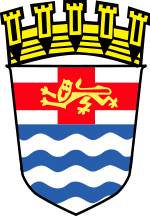London County Council
The London County Council ( LCC ) was the administration of the County of London created in 1889 . It was also the first authority for the entire London metropolitan area to be directly elected. The LCC was responsible for those parts of London that are now commonly referred to as Inner London and was replaced in 1965 by the Greater London Council (GLC).
history
The LCC was founded on March 21, 1889 as part of an administrative reform and was the result of a series of scandals at the previous Metropolitan Board of Works (MBW). The MBW consisted only of appointed representatives and was a superordinate association of the otherwise completely independent municipalities. Decisions were only made in secret; the members were often lobbyists for large construction companies, which created ideal conditions for corruption . The conservative government at the time would have preferred it if there had been no central authority for all of London. But the coalition agreement with the Liberal Unionists left her no other choice. Ten years later, 28 boroughs were created with the status of metropolitan boroughs as the lower tier of two-tier administration; these replaced the numerous civil and parishes that had existed for centuries.
The LCC took over the tasks of the MBW, but also received power of disposal over additional areas of responsibility such as education , urban planning and social housing . From 1899, the LCC gradually took over the private tram companies and electrified their routes. When the LCC Tramways was in turn taken over by the London Passenger Transport Board in 1933 , they were the largest tram operator in the United Kingdom , with a network of 269 kilometers and over 1,700 railcars.
Initially it was hoped that the LCC's elections would not be determined by party politics, but two large political groupings emerged. From 1889, the majority held the purely local Progressive Party , which was unofficially linked to the Liberal Party at the national level . Politicians who described themselves as a "moderate group" gathered around the Conservative Party . In 1906 the moderates adopted the name “Municipal Reform”. The LCC was elected by the people every three years. The progressives held the majority until 1907 when they lost power to the reformers. These controlled the LCC until 1934 and were then replaced by the Labor Party .
In the beginning, the LCC used the MBW building in Spring Gardens near Trafalgar Square . In 1906 the decision was made to purchase three pieces of land on the east side of Westminster Bridge in order to concentrate the entire administration in a single building. County Hall , designed by Ralph Knott , was built in stages from 1909 to 1933.
Chairperson
The County of London did not actually have a mayor. But over time the LCC chairmen took on more and more tasks and their office was de facto similar to that of a mayor. The council chairman was identical to the chairman of the majority party:
- Thomas Farrer (March 21, 1889 - March 27, 1890)
- James Stuart (March 27, 1890 - March 9, 1892)
- Charles Harrison (March 9, 1892 - March 10, 1898)
- Thomas McKinnon Wood (March 10, 1898 - March 8, 1907)
- Richard Robinson (March 8, 1907 - March 11, 1908)
- William Peel (March 11, 1908 - March 8, 1910)
- William Hayes Fisher (March 8, 1910 - December 19, 1911)
- Cyril Jackson (December 19, 1911 - March 16, 1915)
- Ronald Collett Norman (March 16, 1915 - March 1, 1918)
- George Hopwood Hume (March 1, 1918 - March 11, 1925)
- William Ray (March 11, 1925 - March 9, 1934)
- Herbert Stanley Morrison (March 9, 1934 - May 27, 1940)
- Charles Latham (May 27, 1940 - July 29, 1947)
- Isaac Hayward (July 29, 1947 - March 31, 1965)
literature
- Andrew Saint: Politics and the people of London - the London County Council . The Hambledon Press, London 1989. ISBN 1-85285-029-9
